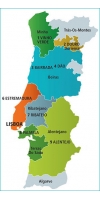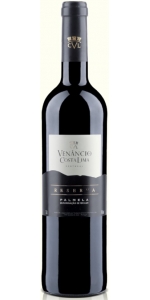Wine from Palmela

Palmela is a Portuguese region located on the Setubal Peninsula. Palmela consists of both plains and hills in the terroir. The main grape type is Castelao, which is a red grape variety. At one time the plains and hills had their own respective wine region titles; however they were combined into the Palmela DOC in 2009. The plains are made up of sandy, deep soil helps the Castelao ripen fully. The wines from Palmela typically have cherry flavors with balance and mature tannin. Fernão Pires and Moscatel de Setúbal are the whites produced in Palmela, however it is important to point out that the Moscatel wines are under the Setubal DOC.
Venancio da Costa Lima Palmela Reserva is made from 100% Castelao (also known as Periquita)
Intense garnet color, complex nose with touches of ripe fruit, jam and spices, full-bodied flavor and a very balanced finish.
100% Castelao (also known as "Periquita" and "Joao de Santarem". As the most widely-grown red grape variety in Portugal it is still often referred to in Portuguese as Periquita, although that name is legally owned by José Maria da Fonseca in the Setúbal Peninsula outside of Lisbon. It is highly adaptable to different climatic conditions and its remarkable versatility enables winemakers to make a range of wines – from the easy drinking and quaffable reds and rosados to the powerful and intense reds perfectly suited to lengthy cellaring. Castelão comes into its own and is most expressive in the Sétubal Peninsula, where it makes meaty and intense wines with aromas of red berries and blue flowers that marry well with the deft use of oak.
Made from 45 year old vines.
Classic vinification at controlled temperature (25 °C) with prolonged maceration for phenolic extraction. Wine went through malolactic fermentation.
Wine was slightly fitered before bottling to avoid sedimentation in the bottle and to ensure stability.
Pasta, Cheese, red meat and game.
- back
Selected Options
Regions
Categories
Pricing
Countries
Regions
Grape Types
Wineries
Organic/Free Shipping
Prager’s stylistic signature is that of aromatic complexity coupled with power and tension. High- density planting and long hang times ensure ripe fruit flavors and concentration, yet allowing leaves to shade the fruit lend vibrant aromatics of grasses, herbs, and wildflowers. Minerality is a constant feature of any Prager wine.
Review:
This is a cool, brilliant and mineral riesling with so much wet stone character alongside lime peel, white grapefruit and small white flowers on the nose. Coriander leaf and root. Sharp and exciting, medium-bodied, precise and full of mountain freshness.
-James Suckling 97 Points
Gentilhommes Macon-Peronne is made from 100 percent Chardonnay.
A gentilhomme is a gentleman characterized by his delicacy, thoughtfulness, and courtesy. "Les Gentilhommes" was created by brothers Richard and Stephane Martin as brand embodying the gentleman's character combined with Burgundian know-how.
From the work in the vineyard to the vinification in barrel, they are inspired to share these noble values. Quality, authenticity and long family tradition are the foundation of these wines.
This single-vineyard Chardonnay is produced in the village of Péronne, in the heart of the Maconnais region in Burgundy, from 40 year-old vines planted on the limestone based soils of the Mount Epin.
A beautiful golden color with green reflections, delicate toasty notes and attractive aromas of citrus and ripe summer fruits combine with floral and honey nuances that are typical of the old vines.
Fresh, ample and full-bodied on the palate, the wine is perfect by itself as an aperitif and delicious during the meal.





